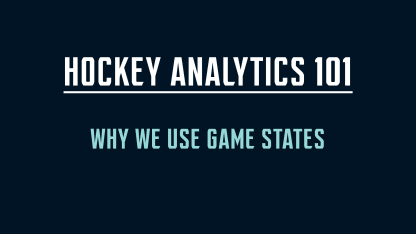If you look at a traditional box score for a hockey game, it includes stats for the entire game. That makes sense, of course, and tells the story of the game as a whole. But, an entire 60 minutes of play can include a variety of scenarios like power plays, penalty kills, or delayed penalties that can influence which players are on the ice, team strategies, and systems. Because of that, when we evaluate play from an analytical perspective, we always want to compare apples to apples and that means using "game states."
Game states are simply indicators that identify which part of the game the stats you are using come from. Are you looking at data only on the power play (PP), on the penalty kill? (PK or SH for short-handed), or at even strength (ES)? You will also see game states defined by the number of players on the ice: 5-on-5, 4-vs-5 (penalty kill), 5-vs-4 (power play). The numeric definitions can be more helpful depending on what questions you are trying to answer because they specify exactly what Game State you are looking at versus some potentially being lumped together (i.e. 4-on-4, 5-on-5, 3-on-3 all being "even strength" situations).
Hockey Analytics 101: Why We Use Game States
Traditional box scores only provide part of the story of a game. That's why it's important to understand "game states" to fully assess performance



















